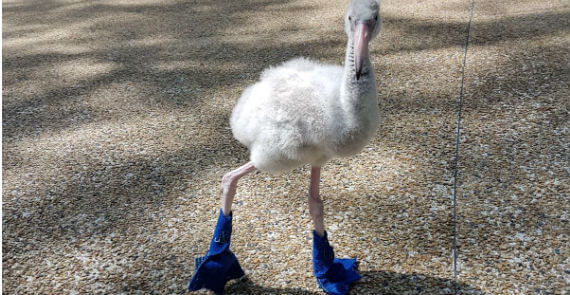Squish standing on its own at Day Five. Greater Flamingos are the tallest in the flamingo family and can grow to a height of almost 1.5m.
Photo Credits: Wildlife Reserves Singapore
A dedicated team of Animal Care staff are hand-raising the chick at Jurong Bird Park’s Breeding and Research Centre; Squish is charming visitors during his daily exercise walks.
For over two months, animal care staff at Jurong Bird Park’s Breeding and Research Centre have been mum to an adorable ball of grey fluff, and even pampering it with a pair of shiny blue shoes. Squish—affectionately named by his human carers for its ‘squish-ability’—is a Greater Flamingo, who was abandoned as an egg. When found by keepers, it was swiftly brought to the incubation room at the park’s Breeding and Research Centre, where it was kept snug and warm for about one month at around 37 degree Celsius, before hatching on 7 June 2017.

Weighing just 90.5 grams at Day One, keepers took turns to keep a constant and close eye on the chick, feeding it a special formula consisting of eggs and multi-vitamins, up to five times a day. The formula is similar to a parent flamingo’s crop milk, which is high in protein. Today, Squish weighs a healthy 1.2kg.
To develop strength in its legs, Squish goes on short exercise walks around the Breeding and Research Centre daily. To protect its delicate foot pads from hard ground surfaces, his carers fashioned a pair of soft blue booties for Squish to plod around in, while having some fun in the sun. In their natural habitats where ground surfaces are softer, flamingo chicks start walking when they are about a week old.
When Squish is not out and about walking, it spends time in the Centre’s weaning room getting used to the outdoor temperature and learning to feed on its own. When Squish reaches three months, it will be introduced to the flock at Flamingo Lake.
Baby flamingos are whitish-grey, and gradually acquire their characteristic pink plumage after around two years from their diet of shrimps, other small crustaceans and algae. Greater flamingos are also the largest of their species. There are currently over 300 Greater Flamingos at Jurong Bird Park’s Flamingo Lake and every year the park breeds several chicks.
Jurong Bird Park also undertakes an annual health check and flu vaccination for waterfowl—such as flamingos—to ensure that the birds are healthy and facilitate early detection of illnesses and treatment.
ABOUT JURONG BIRD PARK
Opened in 1971, Jurong Bird Park is Asia’s largest bird park, offering a 20.2-hectare hillside haven for close to 5,000 birds across 400 species, of which 15% are threatened. The bird park is famed for its large and immersive walk-in aviaries such as Lory Loft, Jungle Jewels and the recently revamped Waterfall Aviary. Other unique exhibits include Penguin Coast and Pelican Cove. Jurong Bird Park sees approximately 800,000 visitors annually.
Committed towards conservation, the bird park is the first in the world to breed the Malayan black hornbill (1995) and the twelve-wired bird of paradise (2001) in captivity for which it received the Breeders’ Award from the American Pheasant and Waterfowl Society. In 2006 and 2007, the Bird Park became the recipient of the Conservation & Research Award for the Oriental Pied Hornbill Conservation Project by IV International Symposium on Breeding Birds in Captivity (ISBBC). It has a Breeding & Research Centre tasked to ensure the welfare, breeding and promulgation of birdlife and the park is also a designated rescued avian centre by the governing authority. Jurong Bird Park is part of Wildlife Reserves Singapore and is the only park in the Asia Pacific to have an Avian Hospital.
Jurong Bird Park












